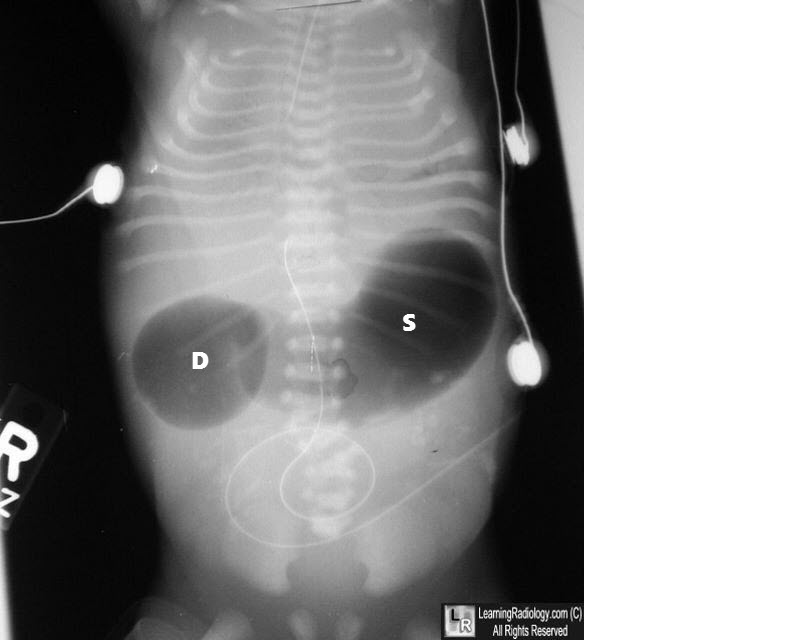|
|
Double Bubble Sign
Duodenal Atresia
- General Considerations
- Seen primarily on radiographs of the abdomen of newborns
- Represents duodenal obstruction from one of several causes:
- Duodenal atresia
- Complete obstruction by an atretic lumen
- Duodenal web or stenosis
- Partial obstruction by a diaphragm
- Milder form of atresia
- Annular pancreas

- Pancreas surrounds the 2nd portion of duodenum
- Since it is frequently associated with duodenal atresia, it has the same conventional radiographic findings
- Malrotation of the bowel with a midgut volvulus, or

- With midgut volvulus, the majority of the small bowel is involved and strangulates if not de-volvulated
- Ladd’s bands
-
Fold of peritoneum (blue arrow below) attaching cecum to abdominal wall crosses over and obstructs duodenum (green arrow)

- Most often associated with duodenal atresia
- Duodenal Atresia
- 1:6,000 newborns
- Atresia is usually just distal to ampulla of Vater
- Most common cause of congenital duodenal obstruction
- Failure of canalization of duodenum
- About 30% of children with duodenal atresia will have Down Syndrome
- Clinical Findings
- Bilious vomiting in first several hours of neonatal life with duodenal atresia
- Imaging Findings
- Larger, proximal “bubble” is air in a dilated stomach
- More distal, smaller “bubble” is air in a dilated proximal duodenum
- There is usually little or no air in the bowel distal to the obstruction
- No oral or rectal contrast is usually needed to diagnose duodenal atresia
- Double bubble may also be seen on prenatal ultrasounds
- Differential Diagnosis
- Malrotation with Ladd’s bands
- Bilious vomiting within 24 hours of birth
- Abdomen not distended
- Malrotation with midgut volvulus

- Distended abdomen
- Child is ill
- Duodenum will not be as distended as with duodenal atresia
- May have bowel gas distal to obstruction
- Treatment
- All congenital causes of duodenal obstruction require surgery
- Prognosis
- If left untreated, it is fatal
- Prognosis will depend on the presence of associated cardiac, tracheo-esophageal, anal, renal, or skeletal abnormalities (VATER)

Double Bubble Sign. Supine radiograph of the abdomen demonstrates a dilated stomach (S) and an accompanying dilated proximal duodenum (D). There is no gas in the bowel distal to the dilated duodenum. This is called the "double bubble" sign and usually indicates the presence of duodenal atresia.
For this photo without the annotations, click here

Double Bubble Sign. Another example. Supine radiograph of the abdomen demonstrates a dilated stomach (S) and an accompanying dilated proximal duodenum (D). There is no gas in the bowel distal to the dilated duodenum. This is called the "double bubble" sign and usually indicates the presence of duodenal atresia.
For more information, click on the hyperlinks indicated by this icon: 
The Double Bubble Sign Traubici, J Radiology. 2001;220:463-464
Duodenal Atresia Mandell, G eMedicine
|
|
|